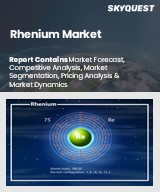
세계의 레늄 시장 규모는 2023년에 6억 1,200만 달러로 평가되며, 2024년 6억 4,750만 달러에서 2032년에는 10억 1,654만 달러로 성장하며, 예측 기간(2025-2032년)의 CAGR은 5.8%로 성장할 전망입니다.
세계 레늄 시장은 항공우주, 국방, 에너지 분야에서 필수적인 고성능 초합금에 대한 수요 증가에 힘입어 꾸준히 성장하고 있습니다. 희소 내화금속인 레늄은 특히 제트엔진이나 가스 터빈과 같은 중요한 엔진 부품에 사용되는 니켈계 초합금에서 뛰어난 고온 강도, 내크리프성, 열 안정성이 중요시되고 있습니다. 민간 항공기 증가와 군용 항공의 현대화는 첨단 소재에서 레늄의 전략적 중요성을 강조하고 있습니다. 그러나 극도의 희소성과 몰리브덴과 구리 채굴로 인한 제한된 1차 정보에 대한 의존도는 가격 변동과 공급망 리스크로 이어질 수 있습니다. 이러한 요인들은 응용 시장의 주기적 특성과 함께 이 분야에 대한 장기적인 안정과 투자를 저해할 수 있습니다.
Global Rhenium Market size was valued at USD 612.0 million in 2023 and is poised to grow from USD 647.5 million in 2024 to USD 1016.54 million by 2032, growing at a CAGR of 5.8% during the forecast period (2025-2032).
The global rhenium market is experiencing consistent growth driven by the increasing demand for high-performance superalloys essential in aerospace, defense, and energy sectors. As a rare refractory metal, rhenium is prized for its remarkable high-temperature strength, creep resistance, and thermal stability, particularly within nickel-based superalloys used in critical engine components like jet engines and gas turbines. The rise in commercial air travel and military aviation modernization underscores the strategic importance of rhenium in advanced materials. However, challenges such as its extreme scarcity and reliance on limited primary sources, primarily from molybdenum and copper mining, lead to price volatility and supply chain risks. These factors, along with the cyclical nature of its application markets, may hinder long-term stability and investment in the sector.
Top-down and bottom-up approaches were used to estimate and validate the size of the Global Rhenium market and to estimate the size of various other dependent submarkets. The research methodology used to estimate the market size includes the following details: The key players in the market were identified through secondary research, and their market shares in the respective regions were determined through primary and secondary research. This entire procedure includes the study of the annual and financial reports of the top market players and extensive interviews for key insights from industry leaders such as CEOs, VPs, directors, and marketing executives. All percentage shares split, and breakdowns were determined using secondary sources and verified through Primary sources. All possible parameters that affect the markets covered in this research study have been accounted for, viewed in extensive detail, verified through primary research, and analyzed to get the final quantitative and qualitative data.
Global Rhenium Market Segments Analysis
Global Rhenium Market is segmented by Type, Application, Industry Vertical and region. Based on Type, the market is segmented into Primary Rhenium and Recovery Rhenium. Based on Application, the market is segmented into Superalloys, Catalysts and Others. Based on Industry Vertical, the market is segmented into Aerospace & Defense, Medical Equipment, Electrical and Electronics, Automotive and Others. Based on region, the market is segmented into North America, Europe, Asia Pacific, Latin America and Middle East & Africa.
Driver of the Global Rhenium Market
The global market for rhenium is primarily propelled by the increasing demand for rhenium-infused superalloys, particularly within the aerospace and defense sectors. Rhenium's remarkable high-temperature strength and resistance to creep make it vital for crucial components found in jet engines, gas turbines, and rocket nozzles. This growing demand is fueled by the expansion of the air travel industry, ongoing advancements in military aviation technologies, and the rising necessity for more efficient propulsion systems. As innovation continues to advance in these areas, rhenium's unique properties will remain indispensable for producing high-performance materials in various applications.
Restraints in the Global Rhenium Market
The global Rhenium market faces significant constraints due to its restricted supply and highly centralized production. This rare element is predominantly obtained as a byproduct from the mining of molybdenum and, to a lesser extent, copper, making its availability contingent on the output of these primary metals. The geographical concentration of Rhenium sources further exacerbates supply challenges, rendering the market vulnerable to price volatility and posing risks to the consistency of supply chain logistics. Even slight disruptions in production can lead to considerable fluctuations in pricing, highlighting the precarious nature of maintaining a stable supply of this invaluable resource.
Market Trends of the Global Rhenium Market
The global rhenium market is increasingly shaped by a pronounced focus on recycling and the principles of a circular economy. With rhenium's rarity and high cost, there is a growing emphasis on extracting the metal from used superalloys, spent catalysts, and various waste materials. This trend is not only driven by the economic advantages of reducing dependency on primary production but also by the environmental imperative for sustainable resource management. As companies seek to enhance supply chain resilience, the recovery of rhenium from secondary sources is becoming a strategic priority, fostering innovation and sustainability within the industry.